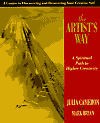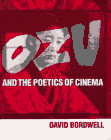 The Artist’s Way, by Julia Cameron with Mark Bryan, has for years been one of the most highly recommended books for anyone interested in developing their creativity, regardless of artform. Artist’s Way groups proliferate on the ’Net and in neighborhoods all over, people study it on their own -- sometimes re-“doing” it on a yearly basis -- the book is a true phenomenon. It outlines a twelve-week program of exercises to unleash and enhance your creativity; some of it is amusing, some baffling, all intriguing and well worth the time and effort.
The Artist’s Way, by Julia Cameron with Mark Bryan, has for years been one of the most highly recommended books for anyone interested in developing their creativity, regardless of artform. Artist’s Way groups proliferate on the ’Net and in neighborhoods all over, people study it on their own -- sometimes re-“doing” it on a yearly basis -- the book is a true phenomenon. It outlines a twelve-week program of exercises to unleash and enhance your creativity; some of it is amusing, some baffling, all intriguing and well worth the time and effort.My personal belief is that anyone who’s drawing comics will find this book more of a refresher course than a liberation, cuz hey, our creativity is already unleashed, right? But follow the course and you’ll come away with ideas and insights about yourself and your work that will astonish you. Quite an experience.
Picture This: Perception & Composition by Molly Bang. One of the toughest things for me to learn about drawing was (and is) composition: learning how to organize pictorial elements to maximize their effectiveness and aesthetic appeal. Judging by a lot of the comic art I see, I’m not the only one who struggles with this [which probably explains why more people don’t appreciate the compositional mastery of Alex Toth] ... and it’s not a topic many how-to books cover in depth.
Picture This is concerned exclusively with composition, and it starts from square one, at a primer level nearly suitable for children. But man is it clear! I came away from this book with a fundamental grasp of composition principles that I never really had before. If you want to really understand the basics of composition and feel confident with them, read this!
 Here’s an odd one, but one of my very favorites:
Ozu and the Poetics of Cinema by
David Bordwell.
This is a very dense, dry, academic tome on the work of Japanese film director
Yasujiro Ozu.
Much of the book is spent discussing the fine points of films most of
us have never seen and never will see. It’s not an easy book to find
[except for
here, of course!
Here’s an odd one, but one of my very favorites:
Ozu and the Poetics of Cinema by
David Bordwell.
This is a very dense, dry, academic tome on the work of Japanese film director
Yasujiro Ozu.
Much of the book is spent discussing the fine points of films most of
us have never seen and never will see. It’s not an easy book to find
[except for
here, of course!  ],
and not an easy book to read. However:
if you persevere, you will find a vast
amount of material here that intensively studies the interactions
of word, image, narrative, and meaning: and
all of these things apply to comics as much as to film. There’s so
much to learn here about the transition from
one image to another and the meaning that transition conveys, how
point of view affects the viewer’s perceptions
of story and character, of the power that comes from controlling the
flow of images and events when telling a
visual story. This is the kind of sutff that I personally find
extremely exciting.
[Which is why I guess it’s a good thing for you that
you’re reading my words from a safe distance and don’t hafta actually
meet me or nuthin....
],
and not an easy book to read. However:
if you persevere, you will find a vast
amount of material here that intensively studies the interactions
of word, image, narrative, and meaning: and
all of these things apply to comics as much as to film. There’s so
much to learn here about the transition from
one image to another and the meaning that transition conveys, how
point of view affects the viewer’s perceptions
of story and character, of the power that comes from controlling the
flow of images and events when telling a
visual story. This is the kind of sutff that I personally find
extremely exciting.
[Which is why I guess it’s a good thing for you that
you’re reading my words from a safe distance and don’t hafta actually
meet me or nuthin....  ]
]Nothing in this book was intended to serve as a textbook on how comics work, but I have found reams of material in here which does just that --- while providing a perspective on the process different from what you’ll find anywhere else. I wrote to Dr. Bordwell and told him that I consider his cinema study to be a textbook on comics as well... and he was delighted!! Obviously a cool guy!